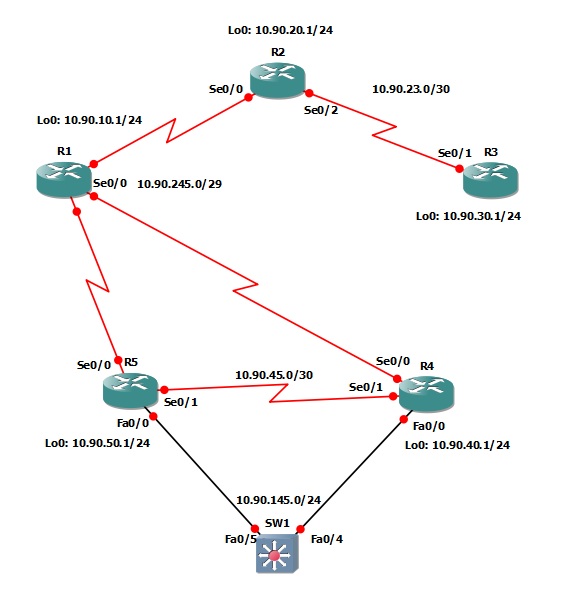Configuring OSPF Route Summarization
Route summarization in OSPF can only be done in two places in OSPF due to the operational nature of protocol. Because the link state database must be the identical everywhere you can’t just do it in random places. This lab will discuss and demonstrate the configuration and verification of OSPF route summarization.
Real World Application & Core Knowledge
If you have completed Lab 7-8 – Configuring RIP Route Summarization and Lab 8-8 – Configuring EIGRP Route Summarization then you’re no stranger to configuring route summarization.
In a nut shell, route summarization is the process of summarizing subnets into a larger subnet to be advertised to upstream routers for ease of management/troubleshooting and resource conservation.
However when working with OSPF you can only summarize at an ABR or ASBR. There are two types of summarization in OSPF; Inter-Area Summarization and External Summarization.
Inter-Area route summarization can only be done on the Area Boarder Router (ABR) and summarize routes from a particular area into the backbone area.
External Route summarization can only be done on an ASBR and summarizes routes to an external destination.
To configure Inter-Area summarization, you’ll use the area # range network netmask command in OSPF router configuration mode. This command can only be issued on an ABR.
To configure External Route summarization you’d use the summary-address network netmask command in router configuration mode. This command can be executed on any OSPF router but will only function on ASBR’s.
In this lab you’re going to create 4 new loopback interfaces on R4 located in Area 44 then create a summary route advertising all 4 routes as a single route into the backbone area.
Familiarize yourself with the following new command(s);
| Command | Description |
|---|---|
| area # range network netmask | This command is executed in OSPF router configuration mode on an Area Boarder Router (ABR) to configure Inter-Area route summarization. These summary routes will be advertised into the OSPF backbone area (Area 0). |
| summary-address network netmask | This command is executed in OSPF router configuration mode on an Autonomous System Boundary Router (ASBR) to configure External route summarization. |
The following logical topology shown below is used in labs found through out Section 9 – Configuring OSPF;

Lab Prerequisites
- If you are using GNS3 than load the Stub Area Networking GNS3 topology than start devices; R1, R2, R3, R4, R5 and SW1.
- Establish a console session with devices R1, R2, R3, R4, R5 and SW1 than load the initial configurations provided below by copying the config from the textbox and pasting it into the respected routers console.
Lab Objectives
- Create 4 new loopback interfaces on R4 located in Area 44 using the ip addresses 10.44.4.0/24, 10.44.5.0/24, 10.44.6.0/24 and 10.44.7.0/24
- Configure R4 to advertise a single Inter-Area summary route into the OSPF backbone that encompasses all 4 routes.
- Verify that the summary route is being propagated correctly by viewing the routing table on R1.
Lab Instruction
Objective 1. – Create 4 new loopback interfaces on R4 located in Area 44 using the ip addresses 10.44.4.0/24, 10.44.5.0/24, 10.44.6.0/24 and 10.44.7.0/24
R4#configure terminal Enter configuration commands, one per line. End with CNTL/Z. R4(config)#interface loopback4 R4(config-if)# %LINEPROTO-5-UPDOWN: Line protocol on Interface Loopback4, changed state to up R4(config-if)#ip add 10.44.4.1 255.255.255.0 R4(config-if)#ip ospf 1 area 44 R4(config-if)#interface loopback5 %LINEPROTO-5-UPDOWN: Line protocol on Interface Loopback5, changed state to up R4(config-if)#ip add 10.44.5.1 255.255.255.0 R4(config-if)#ip ospf 1 area 44 R4(config-if)#interface loopback6 %LINEPROTO-5-UPDOWN: Line protocol on Interface Loopback6, changed state to up R4(config-if)#ip add 10.44.6.1 255.255.255.0 R4(config-if)#ip ospf 1 area 44 R4(config-if)#interface loopback7 %LINEPROTO-5-UPDOWN: Line protocol on Interface Loopback7, changed state to up R4(config-if)#ip add 10.44.7.1 255.255.255.0 R4(config-if)#ip ospf 1 area 44 R4(config-if)#end R4#
Objective 2. – Configure R4 to advertise a single Inter-Area summary route into the OSPF backbone that encompasses all 4 routes.
R4#configure terminal Enter configuration commands, one per line. End with CNTL/Z. R4(config)#router ospf 1 R4(config-router)#area 44 range 10.44.4.0 255.255.252.0 R4(config-router)#end R4# %SYS-5-CONFIG_I: Configured from console by console R4#
Objective 3. – Verify that the summary route is being propagated correctly by viewing the routing table on R1.
R1#show ip route
Codes: C - connected, S - static, R - RIP, M - mobile, B - BGP
D - EIGRP, EX - EIGRP external, O - OSPF, IA - OSPF inter area
N1 - OSPF NSSA external type 1, N2 - OSPF NSSA external type 2
E1 - OSPF external type 1, E2 - OSPF external type 2
* - candidate default, U - per-user static route
o - ODR, P - periodic downloaded static route
Gateway of last resort is not set
10.0.0.0/8 is variably subnetted, 10 subnets, 5 masks
O IA 10.90.50.1/32 [110/64767] via 10.90.245.5, 00:43:29, Serial0/0
O IA 10.90.40.1/32 [110/64767] via 10.90.245.4, 00:43:29, Serial0/0
O IA 10.90.23.0/30 [110/129532] via 10.90.245.2, 00:43:29, Serial0/0
O IA 10.90.30.1/32 [110/129533] via 10.90.245.2, 00:43:29, Serial0/0
O IA 10.44.4.0/22 [110/64767] via 10.90.245.4, 00:00:57, Serial0/0
O IA 10.90.145..0/24 [110/65766] via 10.90.245.4, 00:43:29, Serial0/0
O IA 10.90.45.0/30 [110/129532] via 10.90.245.5, 00:43:29, Serial0/0
O IA 10.90.20.1/32 [110/64767] via 10.90.245.2, 00:43:29, Serial0/0
C 10.90.10.0/24 is directly connected, Loopback0
C 10.90.245.0/29 is directly connected, Serial0/0
R1#
